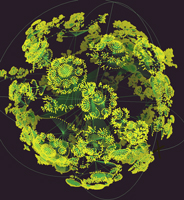The Evolutionary Origins of Modularity: Press Materials
Materials for journalists about the following publication:
Clune J, Mouret J-B, Lipson H (2013) The evolutionary origins of modularity. Proceedings of the Royal Society B. 280: 20122863. http://dx.doi.org/10.1098/rspb.2012.2863 (pdf) (supplementary material)
- Summary
- Images
- Videos
- Press Release One: EurekAlert
- Press Release Two: Cornell Chronicle
- Press Release Three: University of Wyoming
- Frequently Asked Questions (FAQ)
Summary
Engineered and evolved things are organized in modules (e.g. organs or car parts), yet why modularity evolves remains one of biology's most important open questions. This paper shows for the first time that modularity evolves not because it speeds up adaptation, as the leading theory holds, but because it saves on "wiring costs". Connections in biological networks have costs (e.g. building and maintaining them), and modular networks use fewer connections. These results help explain the ubiquitous modularity in biological networks, such as genetic modules and the neural modules in our brains, and will help scientists evolve smarter artificial intelligence. Interestingly, the modular networks that evolve do adapt faster, meaning that adaptation is a consequence of modularity, not its main cause.
See the press releases for more information and the fun history behind the project.
Images

Photo Credit: Steven T. Caputo, CerebralHack.com

Photo Credit: Steven T. Caputo, CerebralHack.com

Photo Credit: Clune, Mouret, and Lipson. 2013.

Photo Credit: Dreamstime.com

Photo Credit: Dreamstime.com

Photo Credit: Dreamstime.com

Permission to use the CAIDA Walrus images for educational, research and non-profit purposes, without fee, and without a written agreement is hereby granted. Please include the following text for the photo Credit: Copyright 2003 The Regents of the University of California. All Rights Reserved.

Permission to use the CAIDA Walrus images for educational, research and non-profit purposes, without fee, and without a written agreement is hereby granted. Please include the following text for the photo Credit: Copyright 2003 The Regents of the University of California. All Rights Reserved.

Jeff Clune

Jean-Baptiste Mouret

Hod Lipson
Videos
Videos of networks evolving with and without a connection cost. The networks with a connection cost are more modular and have higher fitness. See the paper for a description of the node coloring.
Press Release One: EurekAlert
Phone: 607-254-8093
E-mail: bpf2@cornell.edu
Cornell engineers solve a biological mystery and boost artificial intelligence
ITHACA, N.Y. – By simulating 25,000 generations of evolution within computers, Cornell University engineering and robotics researchers have discovered why biological networks tend to be organized as modules – a finding that will lead to a deeper understanding of the evolution of complexity. (Proceedings of the Royal Society, Jan. 30, 2013.)
The new insight also will help evolve artificial intelligence, so robot brains can acquire the grace and cunning of animals.
From brains to gene regulatory networks, many biological entities are organized into modules – dense clusters of interconnected parts within a complex network. For decades biologists have wanted to know why humans, bacteria and other organisms evolved in a modular fashion. Like engineers, nature builds things modularly by building and combining distinct parts, but that does not explain how such modularity evolved in the first place. Renowned biologists Richard Dawkins, Günter P. Wagner, and the late Stephen Jay Gould identified the question of modularity as central to the debate over "the evolution of complexity."
For years, the prevailing assumption was simply that modules evolved because entities that were modular could respond to change more quickly, and therefore had an adaptive advantage over their non-modular competitors. But that may not be enough to explain the origin of the phenomena.
The team discovered that evolution produces modules not because they produce more adaptable designs, but because modular designs have fewer and shorter network connections, which are costly to build and maintain. As it turned out, it was enough to include a "cost of wiring" to make evolution favor modular architectures.
This theory is detailed in "The Evolutionary Origins of Modularity," published today in the Proceedings of the Royal Society by Hod Lipson, Cornell associate professor of mechanical and aerospace engineering; Jean-Baptiste Mouret, a robotics and computer science professor at Université Pierre et Marie Curie in Paris; and by Jeff Clune, a former visiting scientist at Cornell and currently an associate professor of computer science at the University of Wyoming.
To test the theory, the researchers simulated the evolution of networks with and without a cost for network connections.
"Once you add a cost for network connections, modules immediately appear. Without a cost, modules never form. The effect is quite dramatic," says Clune. The results may help explain the near-universal presence of modularity in biological networks as diverse as neural networks – such as animal brains – and vascular networks, gene regulatory networks, protein-protein interaction networks, metabolic networks and even human-constructed networks such as the Internet.
"Being able to evolve modularity will let us create more complex, sophisticated computational brains," says Clune.
Says Lipson: "We've had various attempts to try to crack the modularity question in lots of different ways. This one by far is the simplest and most elegant."
### The National Science Foundation and the French National Research Agency funded this research.
Press Release Two: Cornell Chronicle
Phone: (607) 255-9735
E-mail: amj8@cornell.edu
Scientists find ‘holy grail’ of evolving modular networks
Many biological entities, from brains to gene regulatory networks, are organized into modules – dense clusters of interconnected parts within a complex network. Engineers also use modular designs, which is why a car has separate parts, from mufflers to spark plugs, rather than being one entangled monolith.
Modularity is beneficial, but how did it arise? For decades biologists have tried to understand why humans, animals, bacteria and other organisms evolved this way – what’s the evolutionary pressure to form modular networks, and how can engineers harness that knowledge for artificial intelligence? It’s a central biological question, and Cornell researchers think they’ve finally cracked it.
Modularity evolved, they say, as a byproduct of selection to reduce the “costs” of building and maintaining networks, which is accomplished by reducing network “wiring”: the number and length of network connections.
To test the theory, the researchers simulated 25000 generations of evolution in a computer with and without a cost for network connections. “Once you add a cost for wiring, modules immediately appear. Without a cost, modules never form. The effect is quite dramatic,” said Jeff Clune, former visiting scientist at Cornell and assistant professor of computer science at the University of Wyoming.
The theory is detailed in a Jan. 30 publication in Proceedings of the Royal Society
The results may help explain the near-universal presence of modularity in biological networks as diverse as neural networks (i.e., animal brains), vascular networks, gene regulatory networks, protein-protein interaction networks, metabolic networks and, possibly, even human-constructed networks such as the Internet.
The results also have significant implications for fields that harness evolution for engineering purposes, collectively known as evolutionary computation. Trying to figure out how to evolve modularity has been one of the “holy grails” of these fields, Clune said. He hopes the finding will be especially helpful in work evolving robot “brains” – neural networks that can control robots – to enable them to begin to acquire the intelligence and grace of natural animals, such as gazelles and humans.
“Being able to evolve modularity will enable us to create more complex, sophisticated computational brains,” Clune said.
Clune’s dual background in biology and computer science led him to this work. Nearly 10 years ago, he met Lipson at a conference on evolving artificial intelligence. Lipson told Clune that he believed the key to their field was understanding how to evolve modularity – “I’m betting my career on it,” Lipson said.
Clune decided to join Lipson’s research group at Cornell to work on the problem, although it would take him nearly a decade to arrive on campus and get to work. Mouret flew in from Paris to join the team, and a summer later they had their answer.
“We’ve had various attempts to try to crack the modularity question in lots of different ways,” Lipson said. “This one by far is the simplest and most elegant.”
The work was supported by the National Science Foundation and the French National Research Agency.
For more information email Jeff Clune at jeffclune[at]uwyo.edu.
Frequently Asked Questions
Q: Why is modularity important for evolving artificial intelligence (AI)?
A: The field of evolving AI has produced a lot of impressive results, often beating all other machine learning algorithms and outperforming designs made by hand by human engineers. However, especially in the field of evolving neural networks (NNs), the evolved NNs pale in comparison to the sophistication and abilities of natural NNs (i.e. animal brains). One of the main limitations is that natural NNs are structurally organized in a modular design. However, computationally evolved NNs rarely, if ever, spontaneously evolve to have a modular design. A leading view in our field is that the lack of modularity serves as a "complexity ceiling" that limits the level of intelligence that can evolve. With this discovery, we can break through that complexity ceiling and greatly improve the intelligence of evolved computational neural networks.
Press Release Three: University of Wyoming
Phone: 517.214.1060
E-mail: jclune@uwyo.edu
Written by: Ron Podell
UW Professor Helps Discover ‘Holy Grail’ Theory of Evolving Modular Networks
January 30, 2013 — One of the University of Wyoming’s newest professors has tackled a decade-old question regarding the evolutionary origins of modularity and discovered a new theory for why biological entities are organized into modules.
While a visiting professor at Cornell University, Jeff Clune and fellow researchers discovered this: Modularity in biological networks, such as networks of neurons and genes, does not evolve because it speeds up adaptation, as the current leading theory professes. Rather, modularity in such organisms evolves because it saves on “wiring costs” due to modular networks’ use of fewer and shorter connections.
“Neurons mostly connect only to nearby neurons,” says Clune, an assistant professor of computer science who became a faculty member at UW this month. “Evolution doesn’t want to build tissue it doesn’t need, so it saves on the cost of building and maintaining neural connections by using a modular design.”
This new theory is detailed in a paper titled “The Evolutionary Origins of Modularity,” which was published in the Proceedings of the Royal Society Jan. 30 (today). In addition to Clune, the paper’s authors include Hod Lipson, an associate professor in Cornell University’s departments of mechanical and aerospace engineering and computer science; and Jean-Baptiste Mouret, a robotics and computer science professor at Universite’ Pierre et Marie Curie in Paris, France.
Many biological entities -- from human brains to gene regulation to protein interactions -- are organized into modules, which are essentially dense clusters of interconnected parts within a larger network. These modular designs are similar to how engineers build cars out of various components, such as spark plugs and fuel injectors, or how children create structures from Lincoln Logs or Legos.
Using powerful computers, the research group simulated 25,000 generations of evolution. They were able to test their theory by evolving networks with and without a cost for network connections.
“Once you add a cost for network connections, modules immediately appear,” Clune says. “Without a cost, modules never form. The effect is quite dramatic.”
Clune likened the findings to a road network. Within a city, many of the roads are connected to each other, but few of the local roads are connected to the roads in other cities. Instead, you have just a few connections between cities (e.g. highways). Biological networks are organized similarly, and for a similar reason: it is expensive to build connections (roads), especially long ones.
Clune and his team used computational simulations of evolution for their study for two reasons. It is much faster than natural evolution, allowing evolutionary experiments with thousands of generations to occur in a few days, and it provides more experimental control. It would have been impossible, for example, to conduct this experiment in a naturally evolving species because there is no way in nature to eliminate the cost for connections.
In addition to helping biologists understand why organisms are built in a modular fashion, the results may well have significant implications for evolutionary computation, which is a field that harnesses evolution for engineering purposes, such as evolving artificially intelligent robots.
“Trying to figure out how to evolve modularity has been one of the ‘holy grails’ of this field,” says Clune, whose specialty is artificial intelligence. “We can use this discovery to create more intelligent robots that can find people stranded in an avalanche, pick up trash in national parks or disarm landmines.”
The research was supported by the National Science Foundation and the French National Research Agency. To read the paper, go to http://rspb.royalsocietypublishing.org/content/280/1755/20122863.full.
Photo: Jeff Clune, a UW assistant professor of computer science, was part of a research team that discovered that modularity in humans and other organisms evolves because it saves on “wiring costs” -- the costs associated with building and maintaining network connections encourages the evolution of modular designs, which have fewer and shorter connections.